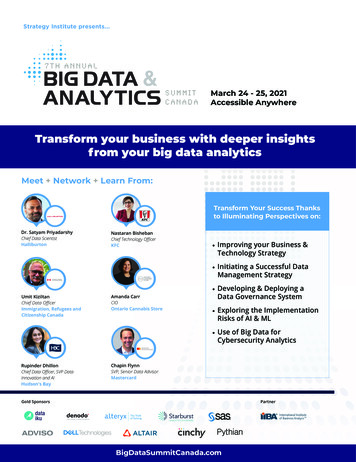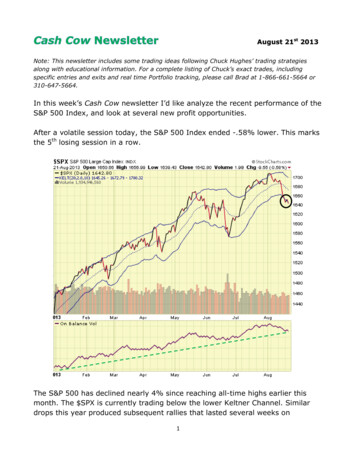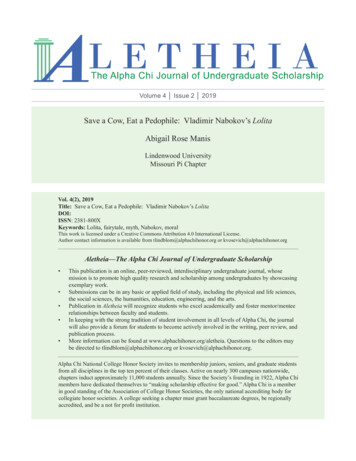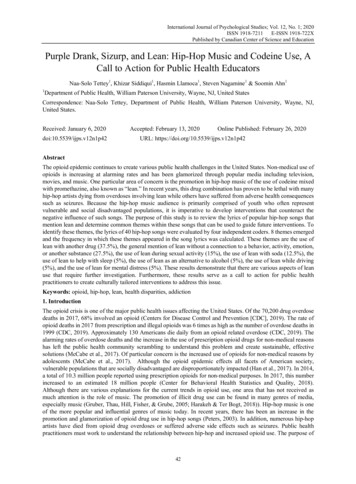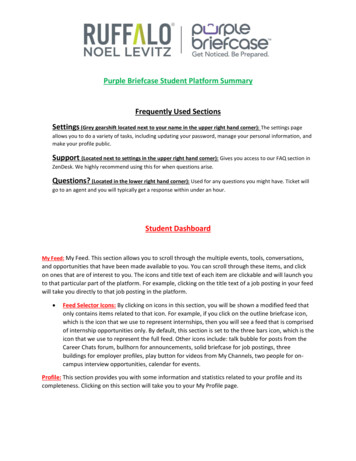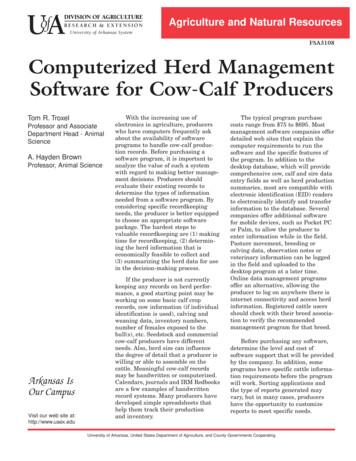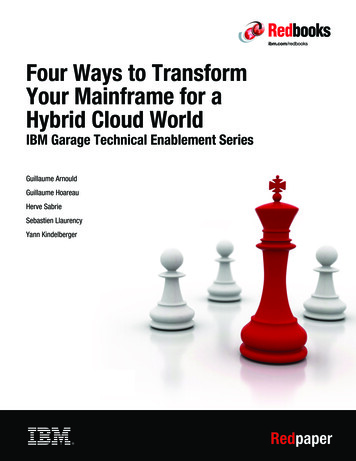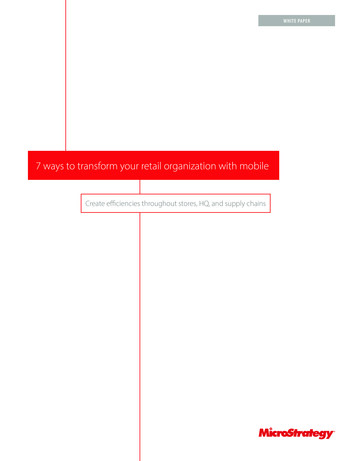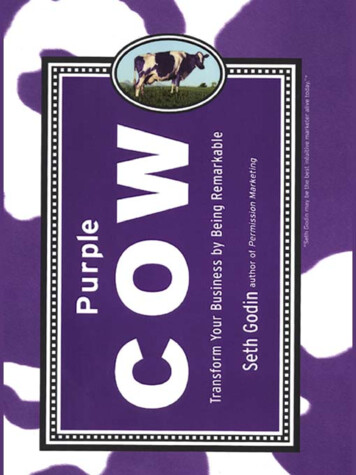
Transcription
Purple CowTransformYour BusinessBy BeingRemarkableSeth Godinvisit Penguin at:www.penguin.come penguin
about the authorSeth Godin is the author of four worldwide bestsellers includingPermission Marketing, Unleashing the Ideavirus and Survival is NotEnough. He is a renowned public speaker and is contributing editor atFast Company magazine.You can find him at www.sethgodin.com
This is a work of fiction. Names, characters, places, and incidents are either the product of the author’simagination or are used fictitiously, and any resemblance to actual persons, living or dead, businessestablishments, events or locales is entirely coincidental.Purple CowPortfolio Book / published by arrangement with the authorAll rights reserved.Copyright 2002 by Do You Zoom, Inc.This book may not be reproduced in whole or part, bymimeograph or any other means, without permission.Making or distributing electronic copies of this book constitutes copyright infringement and couldsubject the infringer to criminal and civil liability.For information address:The Berkley Publishing Group, a division of Penguin Putnam Inc.,375 Hudson Street, New York, New York 10014.The Penguin Putnam Inc. World Wide Web site address ishttp://www.penguinputnam.comISBN: 0-7865-4431-7PORTFOLIO BOOK Portfolio Books first published by Penguin Publishing Group,a member of Penguin Putnam Inc.,375 Hudson Street, New York, New York 10014.Portfolio and the "Portfolio" design are trademarks belonging to Penguin Putnam Inc.Electronic edition: February 2004
In Memory of Lionel Poilane,Remarkable in Every Way.
ContentsNOT ENOUGH Ps1THE NEW P2BOLDFACED WORDS AND GUTSY ASSERTIONS3BEFORE, DURING, AND AFTER4THE GREATEST THING SINCE SLICED BREAD5DID YOU NOTICE THE REVOLUTION?5WHY YOU NEED THE PURPLE COW8THE DEATH OF THETV-INDUSTRIAL COMPLEX13BEFORE AND AFTER17CONSIDER THE BEETLE18WHAT WORKS?20WHY THE WALL STREET JOURNAL ANNOYSME SO MUCH21AWARENESS IS NOT THE POINT23THE WILL AND THE WAY24CASE STUDY: GOING UP?25CASE STUDY: WHAT SHOULD TIDE DO?27GETTING IN28IDEAS THAT SPREAD, WIN31THE BIG MISUNDERSTANDING33WHO’S LISTENING?35vii
ContentsCHEATING38WHO CARES?39NOT ALL CUSTOMERS ARE THE SAME41THE LAW OF LARGE NUMBERS42CASE STUDY: CHIP CONLEY44THE PROBLEM WITH THE COW45FOLLOW THE LEADER51CASE STUDY: THE AERON CHAIR53PROJECTIONS, PROFITS, AND THE PURPLE COW55CASE STUDY: THE BEST BAKER IN THE WORLD58MASS MARKETERS HATE TO MEASURE59CASE STUDY: LOGITECH60WHO WINS IN THE WORLD OF THE COW61CASE STUDY: A NEW KIND OF KIWI62THE BENEFITS OF BEING THE COW63CASE STUDY: THE ITALIAN BUTCHER65WALL STREET AND THE COW66THE OPPOSITE OF “REMARKABLE”67THE PEARL IN THE BOTTLE68THE PARODY PARADOX70SEVENTY-TWO PEARL JAM ALBUMS72CASE STUDY: CURAD74SIT THERE, DON’T JUST DO SOMETHING75CASE STUDY: UNITED STATES POSTAL SERVICE77viii
ContentsIN SEARCH OF OTAKU79CASE STUDY: HOW DUTCH BOYSTIRRED UP THE PAINT BUSINESS81CASE STUDY: KRISPY KREME83THE PROCESS AND THE PLAN85THE POWER OF A SLOGAN87CASE STUDY: THE HÄAGEN-DAZSIN BRONXVILLE89SELL WHAT PEOPLE ARE BUYING(AND TALKING ABOUT!)90THE PROBLEM WITH COMPROMISE92CASE STUDY: MOTOROLA AND NOKIA93THE MAGIC CYCLE OF THE COW94WHAT IT MEANS TO BE A MARKETER TODAY96MARKETERS NO LONGER:NOW WE’RE DESIGNERS98WHAT DOES HOWARD KNOW?99DO YOU HAVE TO BE OUTRAGEOUSTO BE REMARKABLE?102CASE STUDY: MCDONALD’S FRANCE103BUT WHAT ABOUT THE FACTORY?104THE PROBLEM WITH CHEAP106CASE STUDY: WHAT SHOULDHALLMARK.COM DO?108ix
ContentsWHEN THE COW LOOKS FOR A JOB110CASE STUDY: TRACEY THE PUBLICIST112CASE STUDY: ROBYN WATERS GETS IT113CASE STUDY: SO POPULAR, NO ONEGOES THERE ANYMORE114IS IT ABOUT PASSION?117TRUE FACTS119BRAINSTORMS122SALT IS NOT BORING—EIGHT MORE WAYSTO BRING THE COW TO WORKx136BRAND AND COMPANY INDEX138WHAT WOULD ORWELL SAY?142ABOUT THE AUTHOR143MORE INFORMATION144DRINK A PURPLE COW—FOR FREE!145
“Tastes like chicken”isn’t a compliment. “Nobody laughs atold jokes any more.”Max Godin You are a post-consumption consumer.You have everything you need,and most everything you want.Except time. “Marketing is too important to be left to themarketing department.”David Packard “Everything that can be invented has been invented.”Charles H. Duell, 1899,U.S. Commissioner of Patents
Not Enough PsMarketers for years have talked about the five Ps of marketing. (There are more than five of them, but everyonehas their favorite five.) Some of them include: Product Pricing Promotion Positioning Publicity Packaging Pass-along PermissionThis is the marketing checklist: a quick way to make sureyou’ve done your job, a way to describe how you’re goingto go about getting people to buy what the factory justmade. If the elements are out of whack with each other(for example, puréed meals that you market to senior citizens but taste like baby food), then the marketing messageis blurred and ultimately ineffective.1
Seth GodinMarketing isn’t guaranteed to work, but the way thingsused to be, if you got all your Ps right, you were more likely than not to succeed.Something disturbing has happened, though. The Psjust aren’t enough. This is a book about a new P, a P that issuddenly exceptionally important.The New PThe new P is “Purple Cow.”When my family and I were driving through France a fewyears ago, we were enchanted by the hundreds of storybookcows grazing on picturesque pastures right next to thehighway. For dozens of kilometers, we all gazed out thewindow, marveling about how beautiful everything was.Then, within twenty minutes, we started ignoring thecows. The new cows were just like the old cows, and whatonce was amazing was now common. Worse than common.It was boring.Cows, after you’ve seen them for a while, are boring.They may be perfect cows, attractive cows, cows with greatpersonalities, cows lit by beautiful light, but they’re stillboring.A Purple Cow, though. Now that would be interesting.(For a while.)The essence of the Purple Cow is that it must beremarkable. In fact, if “remarkable” started with a P, Icould probably dispense with the cow subterfuge, but whatcan you do?This book is about the why, the what, and the how ofremarkable.2
Purple CowBoldfaced Words and Gutsy AssertionsSomething remarkable is worth talking about. Worthnoticing. Exceptional. New. Interesting. It’s a PurpleCow. Boring stuff is invisible. It’s a brown cow.Remarkable marketing is the art of building thingsworth noticing right into your product or service. Notslapping on marketing as a last-minute add-on, butunderstanding that if your offering itself isn’t remarkable,it’s invisible.The TV-industrial complex was the symbiotic relationship between consumer demand, TV advertising, andever-growing companies that were built around investments in ever-increasing marketing expenditures.The post-consumption consumer is out of things tobuy. We have what we need, we want very little, and we’retoo busy to spend a lot of time researching somethingyou’ve worked hard to create for us.The marketing department takes a nearly finishedproduct or service and spends money to communicate itsspecial benefits to a target audience. This approach nolonger works.I believe we’ve now reached the point where we can nolonger market directly to the masses. We’ve created a worldwhere most products are invisible. Over the past twodecades, smart business writers have pointed out that thedynamic of marketing is changing. Marketers have readand talked about those ideas, and even used some of them,but have maintained the essence of their old marketingstrategies. The traditional approaches are now obsolete,though. One hundred years of marketing thought aregone. Alternative approaches aren’t a novelty–they are allwe’ve got left.3
Seth GodinThis is a book about why you need to put a Purple Cowinto everything you build, why TV and mass media are nolonger your secret weapons, and why the profession ofmarketing has been changed forever.Stop advertising and start innovating.Before, During, and AfterBefore Advertising, there was word of mouth. Products andservices that could solve a problem got talked about andeventually got purchased.The best vegetable seller at the market had a reputation,and her booth was always crowded.During Advertising, the combination of increasing prosperity, seemingly endless consumer desire, and the power oftelevision and mass media led to a magic formula: If youadvertised directly to the consumer (every consumer),sales would go up.A partnership with the right ad agency and the rightbanker meant you could drive a company to be almost asbig as you could imagine.After Advertising, we’re almost back where we started. Butinstead of products succeeding by slow and awkward wordof mouth, the power of our new networks allows remarkable ideas to diffuse through segments of the population atrocket speed.As marketers, we know the old stuff isn’t working. Andwe know why: because as consumers, we’re too busy to payattention to advertising, but we’re desperate to find goodstuff that solves our problems.4
Purple CowThe Greatest Thing Since Sliced BreadIn 1912, Otto Frederick Rohwedder invented sliced bread.What a great idea: a simple machine that could take a loafof bread and.slice it. The machine was a complete failure. This was the beginning of the advertising age, andthat meant that a good product with lousy marketing hadvery little chance of success.It wasn’t until about twenty years later – when a new brandcalled Wonder started marketing sliced bread – that theinvention caught on. It was the packaging and the advertising (“builds strong bodies twelve ways”) that worked,not the sheer convenience and innovation of pre-slicingbread.Did You Notice the Revolution?Over the past twenty years, a quiet revolution has changedthe way some people think about marketing.Tom Peters took the first whack with The Pursuit of Wow, avisionary book that described why the only products with afuture were those created by passionate people. Too often,big companies are scared companies, and they work tominimize any variation –including the good stuff thathappens when people who care create something special.Peppers and Rogers, in The One to One Future, took a simple truth–that it’s cheaper to keep an old customer than itis to get a new one – and articulated the entire field of customer relationship management. They showed that thereare only four kinds of people (prospects, customers, loyalcustomers, and former customers) and that loyal customers are often happy to spend more money with you.5
Seth GodinIn Crossing the Chasm, Geoff Moore outlined how newproducts and new ideas move through a population. Theyfollow a curve, beginning with innovators and earlyadopters, growing into the majority, and eventually reaching the laggards. While Moore focused on technologyproducts, his insights about the curve apply to just aboutevery product or service offered to any audience.Moore’s idea diffusion curve shows how a successful business innovation moves – from left to right – and affects ever more consumers until itfinally reaches everyone. The x-axis, along the bottom, shows the differentgroups an idea encounters over time, while the y-axis shows how many people are in each group.In The Tipping Point, Malcolm Gladwell clearly articulatedhow ideas spread through populations, from one personto another. In Unleashing the Ideavirus, I pushed this idea evenfurther, describing how the most effective business ideasare the ones that spread.And finally, in Permission Marketing, I outlined the evergrowing attention deficit that marketers face. I also discussed how companies win when they treat the attention of6
Purple Cowtheir prospects as an asset, not as a resource to be stripmined and then abandoned.At many companies, most of these proven ideas havebeen treated as novelties. My friend Nancy is the head of“new media” at one of the largest packaged-goods companies in the world. Guess what? She’s in charge (she’s adepartment of one) of all of these new ideas. “New media”has become a synonym for “no budget.”Instead of accepting that the old ways are fading away(fast), most companies with a product to market are treating these proven new techniques as interesting fads – worthanother look but not worth using as the center of theirstrategy.The squeeze play. Marketers can’t get the word out because jaded consumersrefuse to share their attention. Customers rely on their tried-and-true suppliers or on their network of smart friends instead of studying the ads on TV.7
Seth GodinWhy You Need the Purple CowForty years ago, Ron Simek, owner of the Tombstone Tap (abar named for the cemetery next door), decided to offer afrozen version of his pizza to his customers. It caught on,and before long, Tombstone Pizza was dominating yourgrocer’s freezer. Kraft Foods bought the brand in 1986,advertised it like crazy, and made billions. This was a greatAmerican success story – invent a product everyone wants,advertise it to the masses, and make a lot of money.This strategy didn’t just work for pizza. It worked foralmost everything in your house, including aspirin.Imagine how much fun it must have been to be the firstperson to market aspirin. Here was a product that justabout every person on earth needed and wanted. A product that was inexpensive, easy to try, and immediatelybeneficial.Obviously, it was a big hit.Today, a quick visit to the drugstore turns up: Advil,Aleve, Alka-Seltzer Morning Relief, Anacin, Ascriptin,Aspergum, Bayer, Bayer Children’s, Bayer Regimen,Bayer Women’s, BC, Bufferin, Cope, Ecotrin, ExcedrinExtra Strength, Goody’s, Motrin, Nuprin, St. Joseph,Tylenol, and of course, Vanquish. Within each of thesebrands, there are variations, sizes, and generics, addingup to more than a hundred products to choose from.Think it’s still easy to be an aspirin marketer?If you developed a new kind of pain reliever, even onethat was a bit better than all of those I just listed, whatwould you do?The obvious answer, if you’ve got money and you believein your product, is to spend all you’ve got to buy tons ofnational TV and print advertising.8
Purple CowYou’ll face a few problems, though. First you needpeople who want to buy a pain reliever. While it’s a hugemarket, it’s not everyone.Once you find people who buy pain relievers, then youneed people who want to buy a new kind. After all, plentyof people want the “original” kind, the kind they grew upwith. If someone has found a convenient, trusted, effective pain reliever, he’s probably not out there wasting timelooking for a replacement.Finally, you need to find the people willing to listen toyou talk about your new pain reliever. The vast majority offolks are just too busy and will ignore you, regardless ofhow many ads you buy.So . . . you just went from an audience of everyone to anaudience of a fraction the size. Not only are these folkshard to find, but they’re picky as well.Being first in the frozen pizza category was a good idea.Being first in pain relievers was an even better idea. Alas,they’re both taken.Let’s consider yoga books for a second. The problemwith books about how to do yoga is that there are too manyof them.A few years ago, when yoga books were scarce, all a publisher needed to be successful was a good yoga book. Ifpeople had a yoga problem, they’d visit the local bookstore, take a quick look at the three or four books available, and buy one.Today, though, there are more than five hundred bookson yoga. Nobody, no matter how motivated, takes the timeto review all five hundred before buying a book on yoga.So if you’ve just written one, you’ve got a challenge aheadof you. Not only is there a huge amount of competition,but new books on yoga are useless to people who have9
Seth Godinalready solved their yoga problem. All those folks who visited the store a few years ago and made yoga books so popular are no longer shopping for yoga books!Here’s the sad truth about marketing just about anything, whether it’s a product or a service, whether it’s marketed to consumers or to corporations:Most people can’t buy your product. Either theydon’t have the money, they don’t have the time, orthey don’t want it.If an audience doesn’t have the money to buy whatyou’re selling at the price you need to sell it for, youdon’t have a market.If an audience doesn’t have the time to listen to andunderstand your pitch, you’ll be treated as if youwere invisible.And if an audience takes the time to hear your pitchbut decides they don’t want it . . . well, you’re notgoing to get very far.The world has changed. There are far more choices, but there is less and lesstime to sort them out.10
Purple CowThis wasn’t true just twenty years ago. Way back then,consumers had a lot more time and far fewer choices. Ourdisposable income had fewer ways to get squandered, so ifa company came up with a really neat innovation (the cellphone, for example), we’d find a way to pay for it.Years ago, our highly productive economy figured outhow to satisfy almost everyone’s needs. Then the gamechanged – it was all about satisfying our wants. The marketing community taught us (with plenty of TV advertising)to want more and more, and consumers did their best tokeep up.Among the people who might buy your product, most willnever hear about it. There are so many alternatives nowthat people can no longer be easily reached by mass media.Busy consumers ignore unwanted messages, while yourcompetition (which already has market share to defend) iswilling to overspend to maintain that market share.Worse still, people are getting harder to reach by permission media. Just because you have someone’s emailaddress or phone number doesn’t mean they want to hearfrom you! And setting aside the spam issues, even whenpeople do want to hear from you by phone or mail oremail, they are less and less likely to take action. Your satisfied consumers value these messages less because thosemessages no longer solve their current problems.Companies have gotten better at understanding what satisfies their consumers (and presumably have gotten betterat delivering it), so the bar keeps getting raised as to whatproduct news you can possibly deliver that will add to thatsatisfaction. I wasn’t being totally facetious when I quotedthe former head of the U.S. Patent and Trademark Office.Almost everything we can realistically imagine that we needhas been invented.The last hurdle is that ideavirus networks are hard to11
Seth Godinignite in markets that are fairly satisfied. Because marketers have overwhelmed consumers with too much ofeverything, people are less likely to go out of their way totell a friend about a product unless they’re fairly optimistic that the friend will be glad to hear about it. Whenwas the last time someone told you about a new painreliever? It’s a boring topic, and your friend is not goingto waste your time. There’s too much noise, and consumers are less eager than ever to add to it.This is true not just for consumer products but also forbusiness and industrial purchases. People who buy for businesses – whether it’s advertising, parts, service, insurance,or real estate – just aren’t as needy as they used to be. Thefolks who got there before you have a huge inertia advantage.If you want to grow your market share or launch somethingnew, you have a significant challenge ahead.Bottom line? All the obvious targets are gone, so people aren’t likelyto have easily solved problems. Consumers are hard to reach because they ignore you. Satisfied customers are less likely to tell their friends.The old rules don’t work so well any more. Marketing isdead. Long live marketing.12
Purple CowThe Death of theTV-Industrial ComplexRemember the much-maligned “military-industrial complex”? The idea behind it was simple. The governmentspent money on weapons. Companies received tax dollarsto build weapons. These companies hired labor. They paidtaxes. The taxes were used to buy more weapons. A virtuous cycle was created: The government got bigger,employment went up, and it appeared that everyone was awinner.The military-industrial complex was likely responsiblefor many of the world’s ills, but it was undeniably a symbiotic system. As one half of it grew and prospered, so didthe other.Little noticed over the past fifty years was a very different symbiotic relationship, one that arguably created farmore wealth (with large side effects) than the militaryindustrial complex did. I call it the TV-industrial complex. Thereason we need to worry about it is that it’s dying. We builta huge economic engine around the idea of this system,and now it’s going away. The death of the complex isresponsible for much of the turmoil at our companiestoday.The system was simple. Find a large market niche that’sgrowing and not yet dominated. Build a factory. Buy alot of TV ads. The ads will lead to retail distribution andto sales. The sales will keep the factory busy and createprofits.Astute businesses then used all the profits to buy moreads. This led to more distribution and more factories.Soon the virtuous cycle was in place, and a large, profitable brand was built.13
Seth GodinAs the brand was built, it could command a higherprice, generating larger profits and leaving more moneyfor more TV ads. Consumers were trained to believe that“as seen on TV” was proof of product quality, so theylooked for products on television. Non-advertised brandslost distribution and, ultimately, profits.No, it’s not rocket science, but that’s partly why it worked so well. Big marketers with guts (like Procter & Gamble) were able to dominate entire categories by using this simple idea.The old system worked for Revlon. Charles Revson wasone of the first big TV advertisers, and advertising grewhis company dramatically. Where did he spend his profits?On more TV ads.In 1962, a smart ad agency hired Jay Ward, creator ofBullwinkle, and asked him to make a commercial. Heinvented Cap’n Crunch and came back with an animatedcommercial. Then, and only after that was done, did thecereal company go about actually making a cereal. Quakerknew that if they had a commercial, they could run enoughads to imprint the Cap’n into just about every kid inAmerica. The cereal was secondary.14
Purple CowYou could never afford to introduce Cap’n Crunchtoday, regardless of who made your commercial. Kidswon’t listen. Neither will adults.Consumers were kids in the candystore; they had pockets filled with shinymoney and they had a real desire to buystuff. We shopped on TV and weshopped in stores. We were in a hurryand we wanted to fill our houses, ourfridges, and our garages.A quick look down this list of Procter & Gamble brandsturns up significant proof of the presence of the TVindustrial complex. Is it possible to read the list withoutfilling your head with images and jingles?Bold, Bounce, Bounty, Cascade, Charmin, Cheer,Cover Girl, Crest, Dawn, Downy, Folgers, Head &Shoulders, Herbal Essences, Ivory, Max Factor, MissClairol, Mr. Clean, Nice ’n Easy, Noxzema, NyQuil, Oilof Olay, Old Spice, Pampers, Pepto-Bismol, Pringles,Safeguard, Scope, Secret, Tampax, Tide, Vicks, VidalSassoon, and Zest. Throw in particularly annoying product pitches like Wisk and Irish Spring, and the point isobvious. Advertising this stuff used to work. Really well.It’s hard for me to overstate the effectiveness of this system. Every time you buy a box of breakfast cereal, you’reseeing the power of TV at work. Due to a commercial youlikely saw thirty years ago, you’re spending an extra dollaror two on a box of puffed wheat or sugared corn. Overyour lifetime, that’s thousands of dollars in cost premiumfor TV ads just for breakfast cereal.Of course, it wasn’t just supermarket brands. It was JohnHancock and Merrill Lynch and Prudential. ArcherDaniels Midland, Jeep, and Ronald Reagan as well. Bigbrands, big ideas, big impacts on our lives.15
Seth GodinTV commercials are the most effective selling mediumever devised. A large part of the success of the Americancentury is due to our companies’ perfecting this mediumand exploiting it to the hilt.Our cars, our cigarettes, our clothes, our food – anything that was effectively advertised on TV was changed bythe medium. Not only did marketers use television topromote their products, but television itself changed theway products were created and marketed. As a result, all ofthe marketing Ps were adjusted to take advantage of thesynergies between our factories and our ability to capturethe attention of the audience.Of course, it’s not just TV that’s fading. It’s newspapersand magazines – any form of media interrupting any formof consumer activity. Individuals and businesses haveceased to pay attention.The TV-industrial complex lasted a half-century – a longtime. So long that the people who devised the strategies andads that worked so well are gone. There’s no one left atPhilip Morris or General Foods who remembers what lifewas like before TV created the bureaucratic behemoths.And that’s the problem. The TV-industrial complex ishemorrhaging, and most marketers don’t have a clue whatto do about it. Every day, companies spend millions to recreate the glory days of the TV-industrial complex. Andevery day, they fail.The old rule was this:Create safe, ordinary products andcombine them with great marketing.The new rule is:Create remarkable products thatthe right people seek out.16
Purple CowWe can see the same thing in a simple chart:The marketer of yesterday valued the volume of people she could reach. Thecenter of the black curve above was the goal. Mass marketing traditionallytargets the early and late majority because this is the largest group. But inmany markets, the value of a group isn’t related to its size – a group’s valueis related to its influence. In this market, for example, the early adoptersheavily influence the rest of the curve, so persuading them is worth far morethan wasting ad dollars trying to persuade anyone else.Before and AfterTV-Industrial AgePost-TV AgeAverage productsRemarkable productsAdvertise to anyoneAdvertise to the early adopterFear of failureFear of fearLong cyclesShort cyclesSmall changesBig changes17
Seth GodinConsider the BeetleThe ad that launched the Beetle to everyone.The original VW Beetle was not as much of a counterculture car as you may remember. Its sales languished untilsome brilliant advertising saved it. On the basis of thisgreat TV and print campaign, the car was profitable in theUnited States for more than fifteen years. The originalBeetle is a poster child for the power of the TV-industrial complex.In this case, it was the shape, not the ads, that worked.The new Beetle, on the other hand, was a successbecause of the way it looked and the way it felt to drive.Good reviews, great word of mouth, and a distinctiveshape that marketed it far and wide – these factors were18
Purple Cowresponsible for the new Beetle’s success. Every time thevery round Beetle drove down a street filled with boxySUVs, it was marketing itself.After marketing the new Beetle for just three years, VWis now offering incentives, new designs, and other featuresto make the car exciting again. The Purple Cow works,but, alas, it doesn’t last as long as good old TV dominationdid.TV-Industrial Complex ProductsBarbie, Prell, Honeywell, United Airlines,McDonald’s, Marlboro, Cap’n Crunch, BattlingTops, Excedrin, the original BeetlePurple Cow ProductsStarbucks, Magic Cards, Dr. Bronner’s, Linux,JetBlue, Outback Steakhouse, Motel 6, MP3,Dr. Bukk, Prozac, the new Beetle19
Seth GodinWhat Works?One way to figure out a great theory is to look at what’sworking in the real world and figure out what the varioussuccesses have in common.With marketing, though, it’s puzzling. What could theFour Seasons and Motel 6 have in common? Other thanthe fact that both experienced extraordinary success andgrowth in the hotel field, they couldn’t be more different.Or Wal-Mart and Neiman Marcus, both growing duringthe same decade. Or Nokia (changing its hardware everythirty days) and Nintendo (marketing the same Game Boyfor fifteen years in a row).It’s like trying to drive by watching the rear-view mirror.Sure, those things worked, but do they help us predictwhat will work tomorrow?What all of these companies have in common is that theyhave nothing in common. They are outliers. They’re onthe fringes. Super-fast or super-slow. Very exclusive orvery cheap. Very big or very small.The reason it’s so hard to follow the leader is this: Theleader is the leader because he did something remarkable.And that remarkable thing is now taken – it’s no longerremarkable when you do it.20
Purple CowWhy The Wall Street JournalAnnoys Me So MuchThe Journal is the poster child for marketing old-think.Every day, more than a million dollars’ worth of full-pageads run in this paper – testimony to traditional marketers’belief that the old ways are still valid.A full-page ad in the Journal costs more than a house inBuffalo, New York. Page after page of dull gray ads, eachpitching a dull product offering from a dull company.If you took 90 percent of these ads and swapped thelogos around, no one could tell. Switch one stock photo ofa guy in a black derby hat with another stock photo of anearnest-looking pan-Asian smiling employee, and no onecould tell.One morning, with time to kill at a fine hotel, I interrupted a few people who were reading the Journal overbreakfast. I waited until they had finished the first section,and then I asked them if they could name just two of thecompanies that had run full-page ads. Not one personcould.Then I took one of the ads, folded down the bottomwith the logo, and asked the Journal readers which company ran the ad. No idea.Finally, I asked them the million-dollar question (literally). Had they ever requested more information abouta product because they’d seen a full-page ad in theJournal?You can probably guess the answer.It’s not just TV that’s broken. Just about all the waysmarket
Portfolio Books first published by Penguin Publishing Group, a member of Penguin Putnam Inc., 375 Hudson Street, New York, New York 10014. . STIRRED UP THE PAINT BUSINESS 81 CASE STUDY: KRISPY KREME 83 THE PROCESS AND THE PLAN 85 THE POWER OF A SLOGAN 87 . DRINK A PURPLE COW—F
